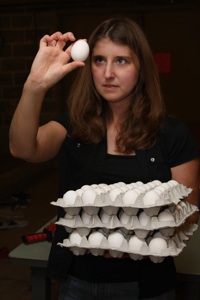
 Sept. 2, 2009 – Chickens, like most animals, typically produce equal numbers of males and females. But this natural sex ratio doesn’t always work in the poultry industry’s economic favour.
Sept. 2, 2009 – Chickens, like most animals, typically produce equal numbers of males and females. But this natural sex ratio doesn’t always work in the poultry industry’s economic favour.

|
|
Sept. 2, 2009 – Chickens, like most animals, typically produce equal numbers of males and females. But this natural sex ratio doesn’t always work in the poultry industry’s economic favor. A University of Georgia researcher is working on ways to skew the chicken’s sex ratio to help the industry streamline production and make more money.
Chickens are big business in Georgia, worth $4.9 billion in 2008, or 41 percent of the state’s total agricultural value.
The industry is split into two areas: meat production and egg production.
For the broiler part of the industry, the females are less profitable. On average, male broilers weigh half a pound more than females at market age, and they eat five percent less feed.
For the egg-layers, females are prized over males, obviously, because males can’t grow up to produce eggs.
Kristen Navara, a poultry scientist with the UGA College of Agricultural and Environmental Sciences, is trying to determine how to control avian sex ratios.
“In nature, it is a necessary strategy to adjust offspring sex in relation to the environment,” she said. “Humans, rodents, birds all skew sex ratios. It is clear females need the ability to adjust offspring for the environment where they will be born or hatched into.”
Navara has recently studied skewed sex ratios in hamsters and humans in relation to day length. She is now looking for the mechanism that can control the ratios in poultry and finches. She’s using hormones, particularly corticosterone, to find that mechanism.
She believes she can flip the ratio to favor males or females using hormones or aggravates, which stop the secretion of corticosterone.
Sara Beth Pinson, a graduate student in Navara’s lab, is coordinating studies to determine the optimal dose of corticosterone to produce the desired result. They are also testing different durations of the hormone treatment to determine how long-term treatments affect offspring sex. Research results could be available in six months.
Focused on species survival, Navara is also looking at sex ratios in zebra finches. “This is where it started, in an ecological context,” she said. “We are really interested in how a species survives. If we could figure out how to adjust the sex ratio of avian offspring, it could really help in conservation efforts.”
This research “is something the industry has been looking for for years,” said Mike Lacy, head of the CAES poultry science department. “The U.S. poultry and egg industry funded Dr. Navara to do this research because it is something the industry is very interested in.”
It is important to note that no chickens used for food are given hormones. Navara’s research is only using hormones to discover the mechanism. “Broilers are not treated with hormones. The industry does not treat with hormones and never will,” Lacy said.
“So far, the hormone injections seem to work, but what we want to do is find the mechanism the hormone is working through and then produce a non-hormonal treatment for the birds. That is the optimal way to go,” she said.
(April Sorrow is a news editor with the University of Georgia College of Agricultural and Environmental Sciences.)
Print this page